Images show a cotton gin and a 1940 U. S. Postage stamp
Topics on the Page


Eli Whitney
Whitney's Upbringing
The Westborough Debate about the Town Seal
The Cotton Gin
The Development of the Cotton Gin
The Controversy of Development
The Importance of the Cotton Gin
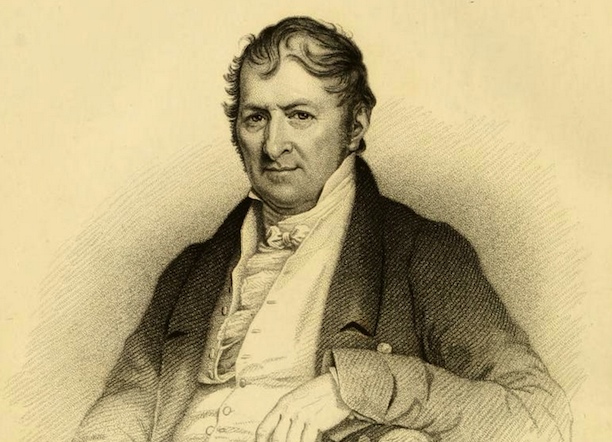
 Cross-Link also AP World History Key Concept 5.1
Cross-Link also AP World History Key Concept 5.1
 What if there had been no mechanized cotton gin at the beginning of the United States southward and westward expansion?
What if there had been no mechanized cotton gin at the beginning of the United States southward and westward expansion?
- The institution of slavery likely would have dwindled, maybe even died out.
- As new territories opened up in the southern interior, Native Americans willing to cultivate farms might well have avoided expulsion (the Cherokee were already adopting agriculture).
- It is even possible that southern society would have evolved as a multiethnic farming region, with Indians, Europeans, and emancipated African Americans living side by side.
How the Cotton Gin Changed the World from Georgia Humanities
Eli Whitney
 Eli Whitney biography from the Eli Whitney Museum
Eli Whitney biography from the Eli Whitney Museum
Eli Whitney's House with a Marker, Westborough, MA

- Eli Whitney was born on December 8, 1765 in Westborough, Massachusetts.
- Text of the Marker at the homesite: "Birthplace of Eli Whitney, Inventor of the Cotton Gin. "Dec. 8 1785-Jan. 8 1825. "Given by Eli Whitney and Henrietta Edwards Whitney"
- His mother died when he was 11 years old.
- At the age of 14, Whitney began working in his father's nail manufacturing business during the American Revolution.
- His stepmother opposed Whitney's goals of a higher education, so he worked on local farms and schools before attending preparatory schools.
- When he discovered he did not have enough money for college, Whitney took up a private tutoring position in South Carolina. There, he ventured towards the South.
- Whitney eventually graduated from Yale. There is now a scholarship program for Yale alumns called the "Eli Whitney Students Program."
Petition by Eli Whitney to the Selectmen of Westborough, MA to run a public school. (Yale University Manuscripts and Digital Archives)
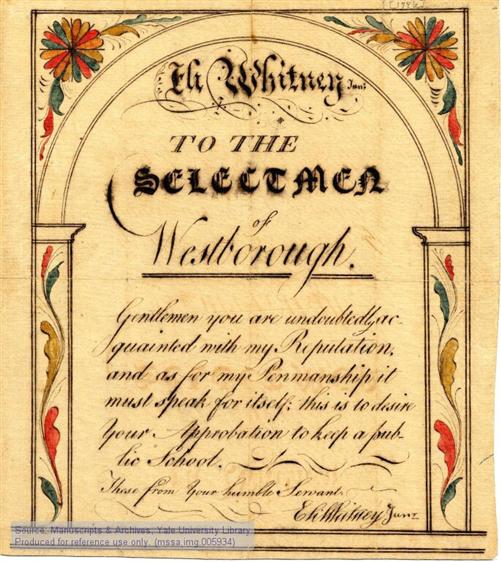
Though Eli Whitney was known for his contributions to the invention of the cotton gin, he is also credited with the first gun with interchangeable parts.
This invention meant that the gun could be taken apart and manually worked upon.
This invention assisted in the Industrial Revolution when it was discovered that machines could also be created to have interchangeable parts. Such revolutionary inventions assisted the North in winning the Civil War.
For more information on the creation of this invention, check: Interchangeable Parts: History Channel
For more on the upbringing of Eli Whitney, see: TBT: Happy Birthday, Eli Whitney!
 The Westborough Debate about the Town Seal
The Westborough Debate about the Town Seal
- In 2022, the Westborough Town Council began the process of debating whether the town should remove the cotton gin from its town seal.
- This debate is surrounded in the idea that the cotton gin was used during the time of slavery and had ties to racism in America.
- Another key element to the development of this debate stems from the murder of George Floyd in 2020. Citizens within Westborough believed that by having the cotton gin on the seal, it promoted the systemic racism and the responses to racism in America.
- As of October 18, 2022, Westborough has removed the seal portraying the cotton gin. They have since reverted back to the 1913 seal.
The current town seal, which was used in 1913. The seal from the town of Westborough as of early October 2022.


The grave marker of the Whitney family, Westborough, MA
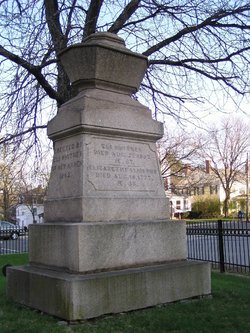
The Cotton Gin and Its Development
 Click here for cotton gin animation using Eli Whitney's patent diagram. Slaves Using a Cotton Gin
Click here for cotton gin animation using Eli Whitney's patent diagram. Slaves Using a Cotton Gin

The Cotton Gin: The importance of this invention is difficult to overstate.
- Before Eli Whitney invented the cotton engine (better known as "gin") in 1793, the cotton industry in the South was struggling.
- The raw material of cotton have two different seeds embedded within the product:
- Long Staple: cotton buds that had longer cotton seeds that were easily removable by hand.
- Short Staple: cotton buds that had minuscule seeds, and extremely difficult to remove by hand.
- Before the cotton gin, slaves had to remove the seeds by hand. For short staple cotton, this would take hours to comb through the entire product.

Average Size Chart for Cotton Staple
- Profit margins on cotton production were very small because the cost of harvesting the crop was so high.
- Slavery was actually beginning to phase out in the south because of the diminishing cotton industry.
- Eli Whitney saw that there was a high demand for a product that could make cotton profitable again.
- His cotton gin reinvigorated cotton's profitability and helped usher in an era of mass production.[9] Plantations dramatically increased in size, slavery became fundamental to the booming cotton industry, and any opportunity for abolition in the south was lost.
- Whitney's cotton gin made it easier for people cultivating cotton.
- Cotton was the staple cash crop for the Southern economy.
- Prior to 1793 cotton production hovered around 150,000 pounds per year.
- However, after the introduction of the cotton gin production soared to 6.5 million pounds in 1795 and increased from there.
- By 1860 the Southern states were producing nearly two billion pounds of cotton per year and Northern textile mills were importing 100% of their cotton from the South.[8]
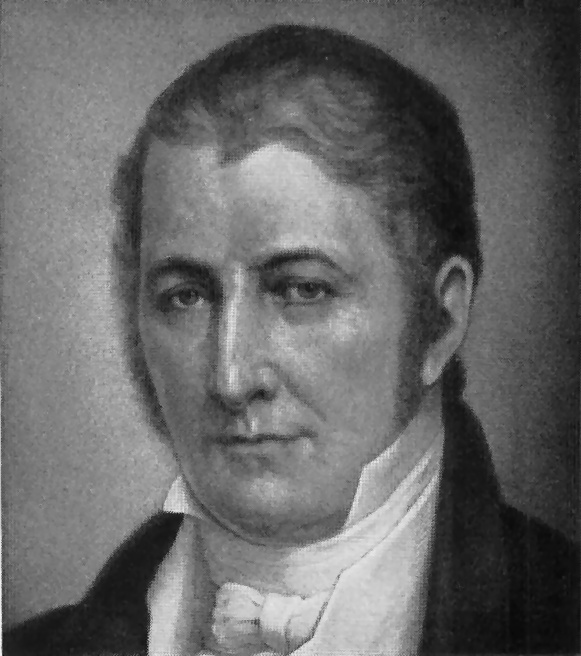 |
| Eli Whitney |
The Controversies of Development
- Credit for inventing the Cotton Gin is given to Eli Whitney. Whitney applied for a patent in 1793 and was given one in 1794.
- There is also some controversy and claims that Catherine Littlefield Greene gave Whitney the initial idea, however there has yet to be discovery of substantial evidence to verify this claim.
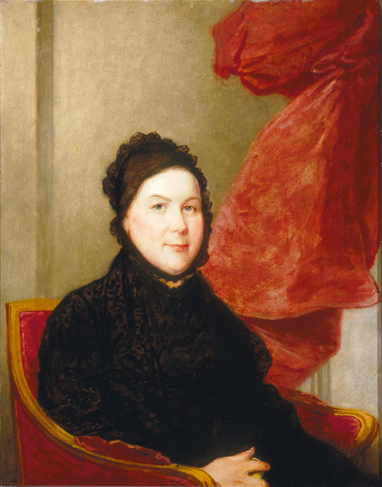
Catherine Littlefield Greene
- Other sources claims that Eli Whitney himself was a black man - but historical sources confirm he was, in fact, a white man.
- It must be noted that in some elementary schools, Whitney is taught as being a black man.
- This controversy spiraled into the belief that the cotton gin was patented by African Americans rather than a powerful, white man. It further diminishes the historical claims of the possibility that Catherine Littlefield Green was the original creator.
Lesson plan for the debate of the invention: Activity: Who Invented the Cotton Gin?
For a news article regarding Whitney being portrayed as a black man, visit: Why So Many People Think Eli Whitney, Cotton Gin Inventor, Was Black
The Importance of the Cotton Gin
The cotton gin transformed the Southern economy, renewing and extending its reliance on slavery.
- The cotton gin had this impact because it greatly increased the value of cotton plantations.
- Prior to this invention, laborers had to pick cotton seeds from harvested cotton by hand. This labor-intensive process limited the scale on which cotton growing could be profitable.
The cotton gin mechanized the removal of seeds, allowing laborers to prepare massive cotton harvests with relatively little difficulty.
- The cotton gin made it profitable to run massive cotton plantations, creating a growing demand for slave labor.
- Prior to the invention of Whitney's cotton gin there had been roughly 700,000 slaves
- By 1850 the slave population had reached almost 3.2 million
Image of the cotton gin patent produced by Eli Whitney
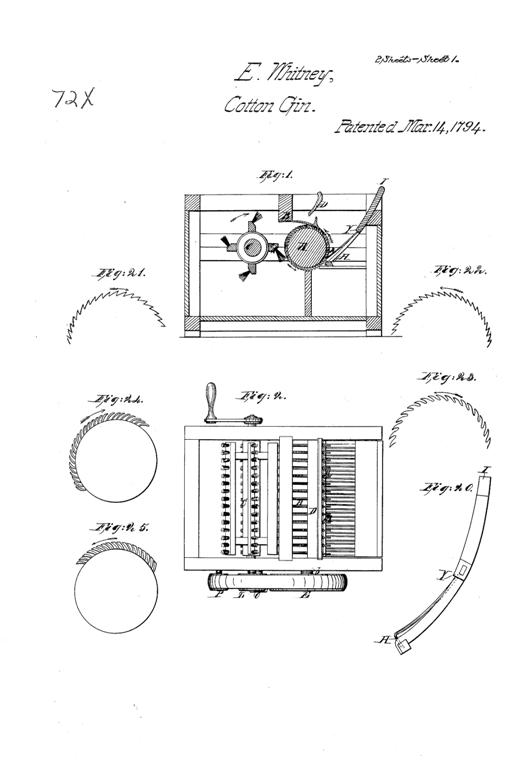
 Eli Whitney's Jr. Letter to his Father this is regarding his invention of the cotton gin (September 11, 1793)
Eli Whitney's Jr. Letter to his Father this is regarding his invention of the cotton gin (September 11, 1793)
 For a lesson plan, see Eli Whitney's Patent for the Cotton Gin.
For a lesson plan, see Eli Whitney's Patent for the Cotton Gin.
Lesson Plan and other resources for an Introduction, here
 Click here for a short video on the invention of the Cotton Gin.
Click here for a short video on the invention of the Cotton Gin.
Watch an animated TED talk on the cotton gin, here.
 For a podcast episode that describes the story of the cotton gin and it's importance amongst African Americans, check out Spotify's: "History that Doesn't Suck!" Episode 20: "A Wolf by the Ears": Gabriel Rebels and Cotton Becomes King
For a podcast episode that describes the story of the cotton gin and it's importance amongst African Americans, check out Spotify's: "History that Doesn't Suck!" Episode 20: "A Wolf by the Ears": Gabriel Rebels and Cotton Becomes King
*The entire podcast describes an enslaved blacksmith who raises a slave army to seize Virginia's capital. The cotton gin is not the focus of the episode, but the discussion of the cotton gin is crucial to understanding the South, its economy and politics.
Comments (0)
You don't have permission to comment on this page.